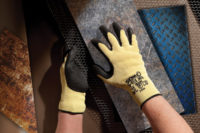
Today’s glove suppliers are faced with a paradox: supply high levels of protection with comfort while keeping costs as low as possible. This is especially true in a segment like the automotive industry, where the pressure to control costs increases annually and where each year purchasers seek to pay less than the year before for the same level of protection.
While more than half of the gloves used in environments where workers need protection against mechanical hazards are made from leather, and cotton is also still widely used, many types of man-made fibers are available today that can offer improved protection and comfort.
Significant change
The move from leather gloves to gloves made of technical fibers is a significant change. Instead of a robust, thick glove, workers can use a knitted glove that is thinner, gives better dexterity and is truly cut-resistant. Since the introduction of man-made fibers like aramids and high-performance polyethylene (HPPE) fibers, the number of hand injuries from mechanical hazards has decreased dramatically. But this is not the final stage of this development. End-users continue to ask for more protection and continuously request greater comfort. And they are right to do so because comfort has a direct link to safety — workers wearing uncomfortable gloves will take them off during work, leaving themselves unprotected.
But even when gloves are worn, hand injuries can happen for several reasons. The most important is that workers are often not aware of the level of protection they need for the job they are doing. There is a large difference in cut-resistance levels between the different types of gloves sold as cut-resistant. A low level of cut resistance should not be used in environments where very sharp knives or other sharp materials are used. But how does the worker know whether or not a glove gives a certain level of protection?
Check the label
The employer has the obligation to provide workers with the right personal protective equipment (PPE). But it is easy to make a wrong selection from the many types available. Without going into the details and quality of the different cut-resistance norms in the U.S. (ASTM 1790) and Europe (EN388), there is one very clear difference: European gloves must have the EN388 norm results spelled out on a label on the glove. As a result, a worker can recognize the cut-resistance level of any glove. The U.S. worker does not have the same advantage, since this kind of labeling is missing. If glove suppliers provided cut-resistance level information on the glove, the worker could check the appropriate level himself.
There are many possibilities to create more comfort and protection against mechanical hazards in gloves. One option is to use man-made fibers like HPPE fibers. For the highest levels of cut resistance, HPPE often has to be combined with glass or steel fiber. Such composite and spun yarns enable the making of thinner gloves with even better protection than before. The different coatings that are used today also contribute significantly to improved comfort and protection. So, yes, the higher demands from end-users can be met — but the level of cut resistance should be made known to the end-user so the full benefit of the gloves can be reached.
Total system costs
At first glance, materials used to meet the demands for more comfort and protection are more expensive than such traditional materials as leather and cotton. Price, however, is only one factor in selecting the right glove. The safety manager and the purchaser who want to achieve the best possible protection for the lowest possible cost should be looking at only one thing: the total system costs. The glove’s lifetime is as important as initial cost per piece or pair. A glove that lasts longer can be a lot cheaper in usage than a glove that wears quickly. In other words, specifiers should ask, “How well does the glove withstand deterioration during usage?â€The glove selection should be further qualified by asking such questions as:
- Does the glove respond to exposure to chemicals?
- Is it abrasion-resistant?
- Is it UV-sensitive?
All of these factors can influence the lifetime of a glove. In the final analysis, a pair of gloves at $6 with a lifetime of ten days becomes a lot cheaper than a pair of $3 gloves with a lifetime of only three days. In addition, as mentioned earlier, comfort has a direct link to safety. And with the cost of a single hand injury potentially ranging from $10,000 to $30,000 or more, a more comfortable glove at a higher price will very likely still be more cost-effective than a cheaper, less comfortable glove. The chance of hand injuries decreases and with that the total system costs.
Paradox solved
To resolve the paradox implied by the simultaneous needs for more comfort, better protection and lower overall cost, safety managers and buyers should avoid the short-sightedness of purchase price alone. Instead, they should seek lower total system costs — how does the glove perform in its usage, what is its lifetime, how comfortable is it, is it really being worn? All these questions have to be answered before a total system cost can be calculated.Instead of competing on lower prices for the same glove, glove suppliers today have the opportunity to differentiate themselves from the competition — and offer customers improved safety — by providing more protection and comfort at lower total system costs.
